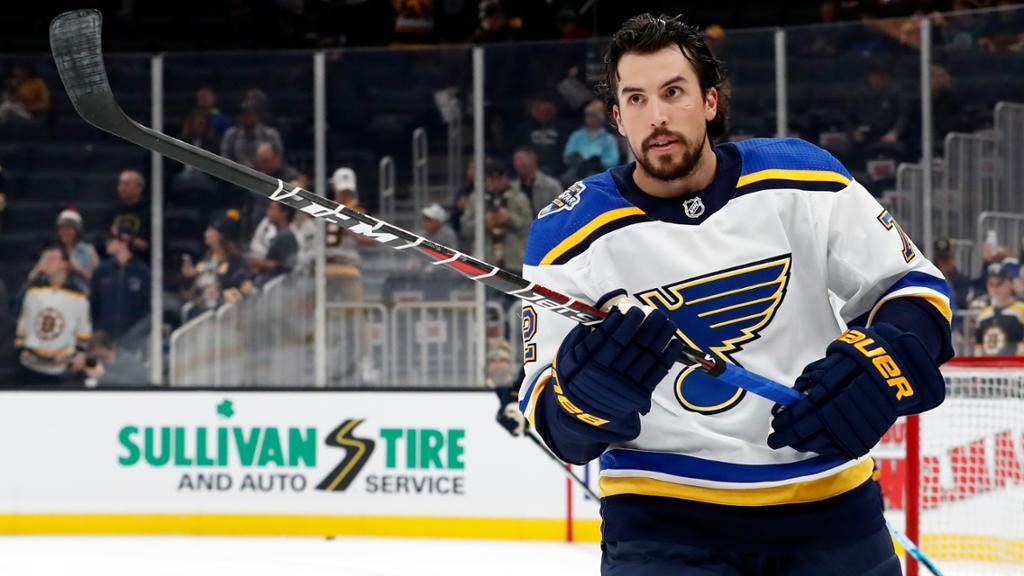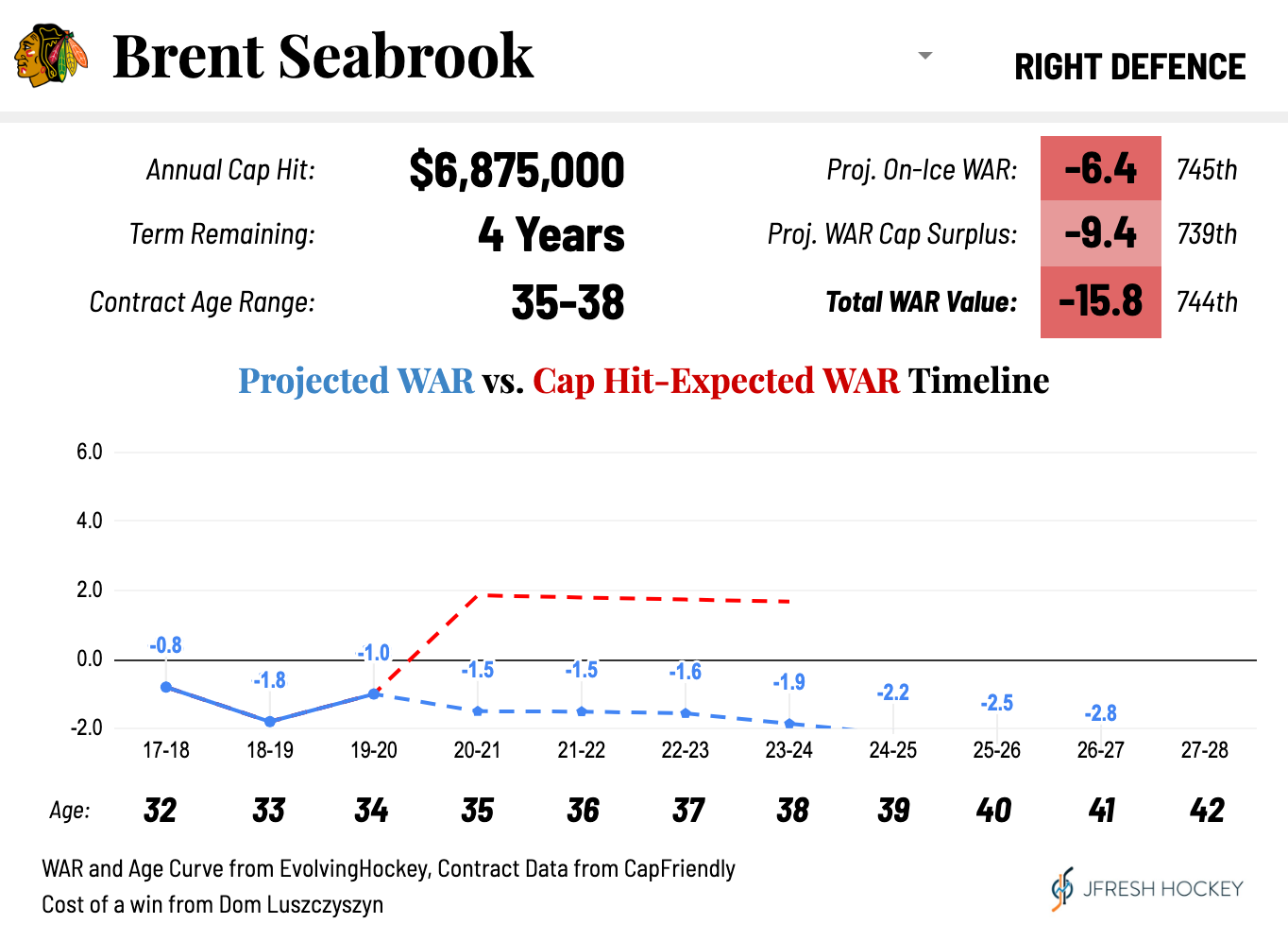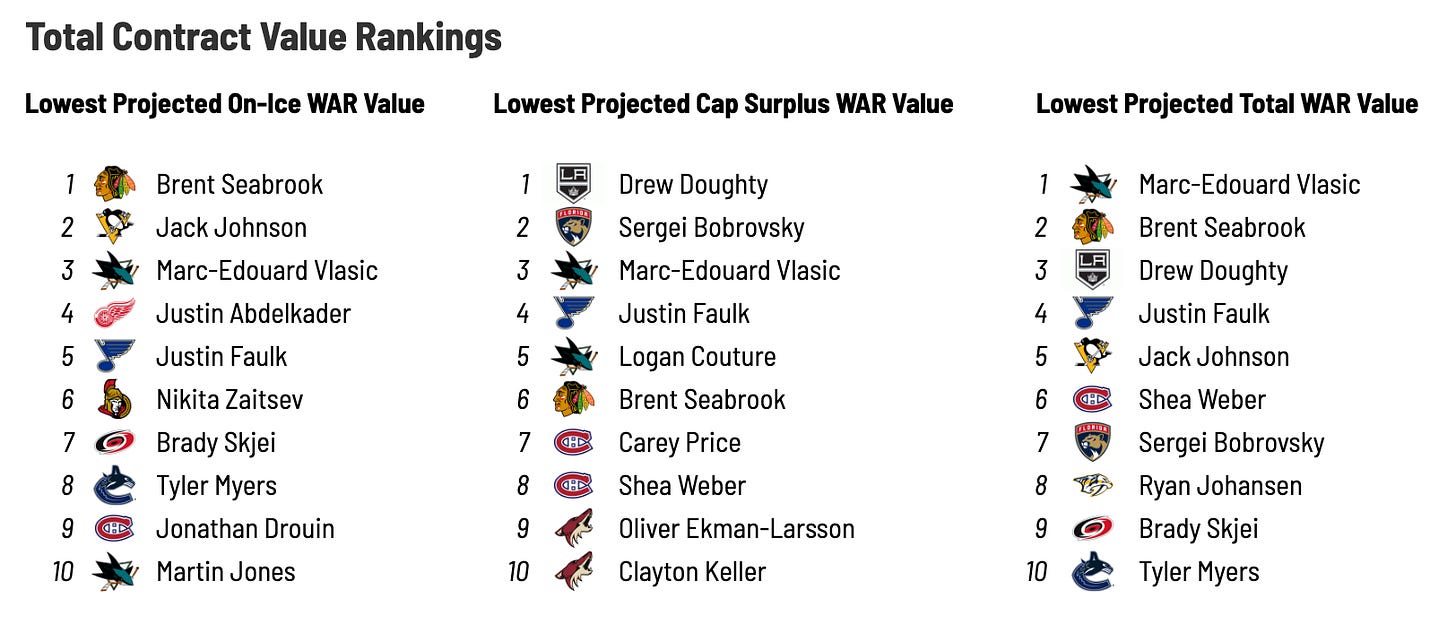Projecting the NHL's 15 Worst Contracts
Using WAR and an Age Curve to find the biggest anchors in the league.

Almost every NHL fan is familiar with the dull sinking feeling when your team signs a contract that you know they’ll regret. Sometimes it’s because the term is too long, and the player will decline long before it expires; sometimes it’s because the cap hit will destroy their flexibility to acquire new talent; sometimes, the player is just bad right now and will make the team worse right away. This list, which uses Wins Above Replacement and an age curve to project the 15 worst contracts in the NHL, will feature all three types of anchor - sometimes all at once.
Methodology
There are two ways that players can provide value through their contracts:
Their Play: This one is pretty self-explanatory; the main way players provide value is by playing good hockey and helping their team win.
Surplus Cap Value: In a cap-scarce environment, having extra cap space is extremely valuable. Players who are underpaid relative to their performance provide wins to their team by giving them the ability to add other players.
I express both of those values in terms of Wins Above Replacement (WAR), a stat built by EvolvingWild that encompasses a player’s contributions offensively, defensively, on special teams, and in penalty drawing/taking in a single number. This number is an estimation of the number of wins a player individually contributed to his team in a season.
1. Their Play: Because player performance changes as a player ages (specifically affecting their WAR), we can’t just multiply a player’s 2019-20 WAR by the number of years left, add them up, and call it a day. We have to use an age curve, which uses league average changes in WAR by age to project how players’ performance will change as they age. Now, players age very differently depending on how they play, their physical attributes, etc. These projections are an estimation based on that historical data. Maybe some of these players will defy nature like Jaromir Jagr, or fall off a cliff like Milan Lucic, but we have no way of telling for sure; in the present moment, what we have to go on is historical data, and that’s what I use. To account for the fact that some players (hi Taylor Hall) had anomaly seasons that could dramatically affect their projected WAR, I used multiple regression to determine a 3-season weighting to predict 2020-21 WAR, and then applied the age curve starting with that season.
2. Surplus Cap Value: Like with age curves, I’ll defer to the historical data here. Dom Luszczyszyn of The Athletic has calculated that a win in the NHL has a market value in terms of cap dollars. Obviously some General Managers are smarter than others and get more bang for their buck overall, but we do at least have a sense of what exactly “fair value” for a contract means. Using Dom’s formula (and my own for goalie value), we can do a few things, like measure how much a player’s performance is worth on the market and how much they’re under/overpaid by. We can also translate that number back into a WAR value, and calculate how many wins a team could buy elsewhere thanks to the extra value they get from a player.
So now that we have a model, let’s get to the good (bad) stuff.
Honourable Mentions: Martin Jones, Duncan Keith, P.K. Subban, Cam Fowler, Kyle Turris, Jonathan Drouin
#15: Jacob Trouba - RD, New York Rangers

Jacob Trouba had a very difficult first season with the Rangers. New York gave him a massive contract extension immediately after acquiring him, establishing him as their #1 defenceman before he’d even played a game for them. Things did not go as planned, to say the least. Trouba was brutal at driving goals for and a mediocre playdriver, continuing his perplexing downward trend since his great first few seasons. With his underlying numbers dropping off, it’s uncertain whether he’ll be able to bounce back to the level the Rangers need him to to get their money’s worth. Despite his sub-replacement season, he’s still projected to provide positive on-ice value (barely), but could cost the Rangers dearly in misspent cap space - an estimated 7 wins.
#14: Oliver Ekman-Larsson

Former “most underrated defenceman in hockey” Oliver Ekman-Larsson has reversed course in recent years, declining at even strength at an alarming rate. Following a disastrous 18-19 campaign he did improve a bit this season, but most of those gains came on the powerplay. Even with that special teams bump, he still performed well below his paygrade. OEL is signed well into his thirties, and in that time is projected to provide the Coyotes with only 1.6 more wins than a replacement-level player would. In the meantime, the contract will cost the Coyotes almost that much each year in terms of lost wins.
#13: Justin Abdelkader

Justin Abdelkader is paid like an NHL middle-sixer, but for the past two years he’s played more like an AHL middle-sixer. No forward is projected to provide lower on-ice value on his current contract than the Red Wings veteran, as age compounds already-present issues in his game. The relatively short term remaining on this deal keeps it from the top part of this list, but this has to be considered one of the worst contracts of the cap era.
#12: Jean-Gabriel Pageau - C, New York Islanders

I’m going to editorialize here and say that I personally find this projection a little harsh. I do not think that this is a good contract, and I think paying Pageau for an outlier season in which he played first-line minutes for Ottawa and got a big boost from the powerplay was a mistake. But his WAR projection is heavily weighed down by an 18-19 season in which he had a 4.6% on-ice shooting percentage. (Using multiyear weightings generally balances out these issues, but this is an extreme example). In my books he’s more of a ~$3M player getting paid too much for far too long.
#11: Nikita Zaitsev - D, Ottawa Senators

After I crowned him the Anti-Norris Trophy Winner for Worst Defenceman of 2019-20, there was no way he was getting left off of this ranking. Zaitsev has two attributes common among defencemen on this list: sub-replacement play and the inexplicable trust of his coach to play big minutes. The Russian blueliner has been a negative-impact player in all but one of his NHL seasons, although he has curiously exchanged the awful defensive play of his rookie year for anemic offensive contribution. Zaitsev’s presence on the Sens over the next four years is projected to cost the team 3.5 wins on the ice and over 5 in terms of squandered cap money - and that’s assuming he improves somewhat from the previous two seasons. Why did Ottawa trade for this contract again?
#10: Tyler Myers - D, Vancouver Canucks

There are some bad contracts that looked okay when they were signed, and some that looked awful from the first beat reporter rumour. This is the latter. Myers has been a below-replacement player seven times in his 11-year career, banking on his size and excellent rookie season ever since. It is revealing that this season - where despite adequate relative numbers his isolated impact on defence was very bad - was actually average by his standards. As he enters his thirties, Myers projects to decline further, costing the Canucks almost three wins on the ice and almost six in lost cap space in the remaining four years of his contract.
#9: Brady Skjei - D, Carolina Hurricanes

What happened to Brady Skjei? After a remarkable rookie season with the Rangers in 2016-17, Skjei has been way below-replacement in two out of three seasons. This year in particular was a disaster; his defensive numbers were awful, his offence evaporated, and he cost his team with penalty-taking. Having just spent a first round pick on him, the Hurricanes clearly think he can turn things around and regain his rookie form. But it’s anything but a sure bet - I mean, look at Tyler Myers. Skjei is still in his prime, and shouldn’t decline for age reasons during this contract. But it’ll take a massive improvement for him to have been a smart investment on a team that already has Jaccob Slavin, Haydn Fleury, and Jake Gardiner on the left side.
#8: Ryan Johansen - C, Nashville Predators

Ryan Johansen is a player that analytics were never as kind to as his reputation dictated. For the four years before he signed his $8M long-term extension in Nashville, his expected cap hit hovered between $4.8-$5.5 million - a decent second-line centre, but not a franchise forward by any means. If he had kept up that play, this contract would be pretty bad. But Johansen’s steady decline since the Predators’ Stanley Cup finals appearance (and since he got paid) makes it a disaster. The projection, which assumes that he won’t continue to decline at the rate he is now, places him as a net negative player in all five remaining seasons. The gap between first liner money and sub-replacement performance is huge, and will cost the Preds dearly as they try to keep their window open.
#7: Sergei Bobrovsky - G, Florida Panthers

NHL teams want certainty in goal. They want to know that they don’t have to worry about it every year, they want to avoid 1A/1B controversies, and they want their coaches and defencemen to know they have someone reliable in net. In part, this is because they recognize just how much of a wildcard goaltending is, and want to beat that system. But chaos always wins. Consistently “elite” goaltending is an absolute myth in today’s NHL, and even expecting reliably good performance from year-to-year is optimistic. That’s why you must never pay goalies elite skater money, let alone over longterm. The Panthers didn’t understand this (or convinced themselves they were the exception), and as a result are stuck with a notoriously inconsistent player who’s projected to provide them with only 1.3 more wins in six seasons than they would otherwise have received from a guy making far less.
#6: Shea Weber - D, Montréal Canadiens

Age comes for us all one day. Weber, the only player on this list with a pre-2013 contract, has been extremely inconsistent during his tenure in Montréal. In the past three seasons he’s been a great driver of shot attempts, but those haven’t translated into goals very well (too many shots from the point?). What he provides to the Habs in terms of veteran leadership hasn’t always translated on the ice, and as he enters his late thirties things are projected to go sideways fast. This estimation might again be a little harsh, influenced by his poor injury-shortened 17-18 campaign, but considering the way he plays and his injury history, a sudden decline near the end of his career is by no means out of the question. It’s far less likely that his final six years will be worth over $47 million.
#5: Jack Johnson - D, Pittsburgh Penguins

This was a headscratcher on day one, and has only gotten worse ever since. No defenceman has been worse overall in the past two seasons than Jack Johnson, as he’s cost the Penguins almost 3 wins in that time. He’s a huge negative at both ends of the ice, an incompetent penalty killer despite his reputation, and at 33 there’s no reason to believe things are going to get any better. That he’s this high on the list despite the relatively small cap hit and short term are a testament to just how much of a liability he is for the Penguins.
#4: Justin Faulk - D, St. Louis Blues

I still cannot figure out what the hell the Blues were thinking on this one. The last thing a team coming off of a Stanley Cup with Alex Pietrangelo and Colton Parayko on the right side, a perfectly functional powerplay, and limited cap maneuverability needed was a replacement-level special teams specialist signed at a huge number until he’s 34. As an insurance policy on upcoming UFA Pietrangelo it doesn’t make sense, and in fact limits their ability to re-sign him. Faulk is a massive anchor, projected to provide negative value throughout his contract to the tune of 4.5 total on-ice wins and over 10 from the cap - will some of those lost wins be from a departing Pietrangelo or Vince Dunn?
#3: Drew Doughty - D, Los Angeles Kings

As I’ve gently pointed out elsewhere, Drew Doughty is not what he once was. His sudden decline is a big reason why the Kings have fallen apart in recent years, as his diminished effort level due to the team’s struggles have become a self-fulfilling prophesy. Some have argued that an improved Kings team could inspire him to play his best again, but it’s never a sure thing that a player over 30 can regain his former greatness. For now, all we have to go on is his recent play and his age, which does not paint a pretty picture. His highest projection is 0.3 WAR (worth about $1.7M), and four of these seasons are expected to be sub-replacement level. For the second-highest paid defenceman ever, that’s a recipe for a cap catastrophe. He’s projected to cost the Kings 14.5 wins in terms of cap space lost, the highest in the league.
#2: Brent Seabrook - D, Chicago Blackhawks

There’s a reason teams lock up aging players who were key to Cup runs to retirement contracts: loyalty, legacy, etc. But sometimes you have to know when to let them walk away. Seabrook is a perfect example. His stats were decent in 2014-15, the year before this extension was signed, but not exceptional enough to warrant such a high cap hit, let alone on an eight year contract stretching into his late thirties. Mostly through his truly appalling defensive play, Seabs has seen himself become the villain in Chicago, continually playing well below-replacement-level hockey. If this contract doesn’t get LTIR-buried, it will continue to sting the retooling Hawks. His -6.4 projected wins are the lowest of any contract in the league, and the -9.4 cap surplus wins are near the bottom as well.
#1: Marc-Édouard Vlasic - D, San Jose Sharks

From 2012-13 to 2017-18, only Niklas Hjalmarsson provided more defensive value to his team than Marc-Édouard Vlasic provided the Sharks. Unlike many blueliners considered to be “stay-at-home” types, Vlasic actually did prevent quality chances against at an exceptional rate, and he did it while being insanely underpaid; he should have been making $7-8 million dollars a year for those six seasons. I’m happy for him that he finally got that money, but unfortunately for the Sharks they gave it to him too late. Vlasic has fallen off a cliff in the past two seasons, and even if he can recover somewhat it’s going to be a long six years for the Sharks - especially as he continues to age. He’s already costing the Sharks on the ice, as his reputation and salary force the Sharks to play him in the top four and compromise Burns or Karlsson (both have struggled mostly when paired with him). Considering the Sharks’ already-tight cap situation, his contract will have a huge impact on their ability to fill out their lineup with quality pieces. These factors combined give him the league’s worst contract.




Im a LITTLE surprised that Lucic isnt here
Jarmo Kekalainen is the best GM in hockey for passing on/letting several of these guys walk because the price was too high.